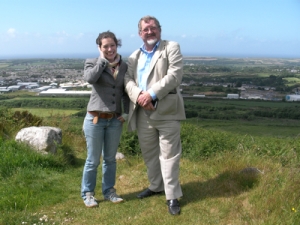The draft Management Plan for the Old and New Towns of Edinburgh World Heritage Site has been created by Edinburgh World Heritage, Historic Scotland and the Council. It was approved by the Planning Committee of the Council as a draft for consultation and we are now seeking your help to further develop and finalise the plan.Read more

The case of Orkney Wind Turbines
Scottish Ministers announced today their decision to refuse planning permission for the proposed development of three wind turbines at Merranblo, Stromness, Orkney. The application was considered at a local public inquiry in January 2008. ICOMOS-UK appeared at the inquiry along with other organisations, such as Historic Scotland, Orkney Archaeological Trust, Orkney Skyline Concern and Scottish Natural Heritage.
The World Heritage Site (WHS) in Orkney was inscribed on the World Heritage List as “a major prehistoric cultural landscape that provides a graphic depiction of life in a remote archipelago in the far north of Scotland some 5,000 years ago. […] The monuments of Orkney, dating back to 3000-2000 BC, are outstanding testimony to the cultural achievements of the Neolithic peoples of northern Europe” (UNESCO World Heritage Centre). At the Inquiry ICOMOS-UK expressed concern about the adverse impact of the turbines on the historic environment of the WHS and its setting, as we believed that the site of the proposed development was located within the area of visual impact of the WHS.
The World Heritage Convention in 1972 was set out to identify, protect and preserve for future generations cultural and natural heritage around the world considered to be of outstanding universal value to humanity. ICOMOS-UK believed that the erection of the proposed wind turbines would compromise this very sensitive Scottish landscape and therefore have a detrimental impact on the outstanding universal value for which the WHS was inscribed in 1999.
The report by the Scottish Ministers concluded that “given the international importance of the cultural heritage resources of the area […] the objective of preserving these monuments within an appropriate setting is consistent with the fundamental objectives of national policy”.
Student Mining Heritage project

Leonor Medeiros with Stuart Smith, international industrial heritage expert, on Carn Brea overlooking Camborne mining town, Cornwall
Leonor Medeiros, while studying for a Masters in Heritage Management at the Ironbridge Institute, successfully completed her Work Attachment project with ICOMOS-UK at the end of June. Her project compared the experiences of UK and Portuguese mining sites and landscapes, identifying good practice in Britain to take home to Portugal.
The Report, entitled: ‘Managing Mining Landscapes: Sharing Experiences from the United Kingdom and Portugal‘, considers three sites in southern Portugal, situated on one of the largest sources of iron sulphide in the world, the Iberian Pyrite Belt. These are Lousal, Aljustrel and S. Domingos. Through site visits and meetings with conservation and heritage professionals at Blaenavon Industrial Landscape World Heritage Site and Cornwall and West Devon Mining Landscape World Heritage Site, Leonor learned about challenges concerning conservation, interpretation and opportunities for sustainable development and regeneration through, for example, cultural tourism.
Attending the ICOMOS-UK Summer Conference on Cultural Landscape Management enabled Leonor to meet several people involved in the management of industrial heritage, and in addition to field visits in the UK and Portugal, gained valuable experience in understanding how international guidelines such as the European Landscape Convention can be implemented for the successful conservation and presentation of a site.
Continue reading
